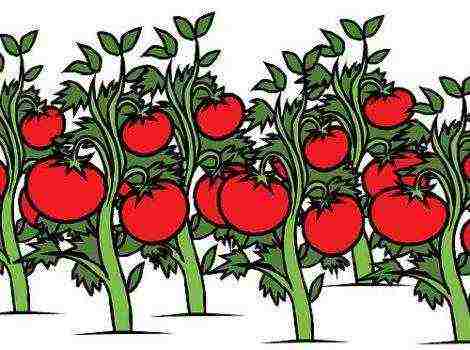Content
- 1 1. Bluegold
- 2 2. Bluecrop
- 3 3. Blurey
- 4 4. Bonus
- 5 5. Herbert
- 6 6. Jersey
- 7 7. Duke
- 8 8. Northland
- 9 9. Patriot
- 10 10. Elizabeth
- 11 Description
- 12 What varieties of American blueberries to choose?
- 13 The best varieties of blueberries with photos
- 14 The most popular early varieties
- 15 Most popular late varieties
- 16 Conclusion
- 17 Blueberries - tasty and healthy
- 18 Blueberry varieties
- 19 Planting and leaving
Tall blueberry, or garden blueberry, is a beautiful and healthy plant. By planting bushes of one of these 10 varieties around the perimeter of the garden, you will get a charming hedge that every summer will delight you with a rich harvest of delicious and very healthy berries.
Gardeners began to cultivate wild blueberries only 100 years ago, so we can safely say that garden blueberries are a young culture. This berry is attractive both as an ornamental plant and as a berry shrub, which gives a high-quality, tasty, vitamin-rich harvest.
If for some reason you still have not managed to "settle" tall blueberries in your garden, we advise you to try one of these varieties.
1. Bluegold
This popular blueberry variety is light blue with a dense, aromatic flesh. And the bushes themselves are lush and beautiful, so they will be a wonderful decoration for any garden. However, it should be borne in mind that spreading is at the same time a lack of bushes of this variety, because they require strong pruning.
Bluegold is an early variety. The fruits acquire a rich color at the beginning of summer and ripen amicably by mid-July. From one bush, from 4.5 kg of berries are harvested, even in not the most productive years.
This blueberry can withstand frosts down to -35 ° C, therefore it is suitable for growing in northern regions. The weak side of the variety is that its berries wilt quickly, mummify, especially if the summer is hot.
Bluegold berries crumble when overripe, so it is important to harvest on time!
| Maturation | Bush height (m) | Berry diameter (mm) | Productivity (kg per bush) | Peculiarities |
| Mid july | 1,2-1,5 | 16-18 | 4,5-7 | High frost resistance |
2. Bluecrop
This mid-season American blueberry was developed over half a century ago. Berries are light blue, large with firm pulp. They can be easily identified by their characteristic flattened shape.
It is worth planting several Bluecrop bushes on your site because the plants of this variety are not afraid of snow, or heat, or pests and viruses, and the fruits themselves do not crack when overripe, withstand transportation with dignity, are well stored and do not lose their rich taste when frozen.
| Maturation | Bush height (m) | Berry diameter (mm) | Productivity (kg per bush) | Peculiarities |
| End of July - August |
1,6-1,9 | 17-20 | 6-9 |
Disease resistance, |
3. Blurey
What gardener does not dream of a shrub that will delight with lush flowering in spring, excellent harvest in summer and fabulously beautiful fiery foliage in autumn? If you were looking for such a plant, consider that you have already found it! Blueberries of the Blurey variety don a romantic pink dress in the spring, and change it to a fiery red dress in the fall.
The berries are juicy, very sweet, shiny, deep blue in color. The bushes are literally strewn with them, tk. Blurey gives not just a bountiful, but an excessive harvest. However, excessive fruiting is at the same time a disadvantage of the variety, because it depletes the plant. When choosing blueberries of this variety for your garden, this feature should be taken into account.
The variety has one more strong side - it is very winter hardy.Blueberries Blurei can withstand frosts down to –34 ° С.
These berries are best eaten fresh. Moreover, they remain so for a long time and do not crack even when they are overripe.
| Maturation | Bush height (m) | Berry diameter (mm) | Productivity (kg per bush) | Peculiarities |
| End of july | 1,2-1,8 | 12-17 | 5-8 | Prone to excessive fruiting |
4. Bonus
If you see a coin-sized blueberry on the market, there is a 99.9% chance of it being a Bonus berry. Perhaps this is the largest-fruited tall blueberry that can be grown in your summer cottage.
The berries themselves are fragrant, dense, sweet. They are suitable both for fresh consumption and for freezing. This blueberry gives a good harvest and tolerates frosty winters with dignity. Isn't it a gardener's dream?
|
|
||||
| Maturation | Bush height (m) | Berry diameter (mm) | Productivity (kg per bush) | Peculiarities |
| July August | 1,5-1,6 | 20-30 | 5-8 | Good winter hardiness |
5. Herbert
Herbert blueberry is one of the best you can grow in your garden. This is in the full sense of the word a tall blueberry - the height of a bush can reach 2.2 m!
Of course, the fruits are not as gigantic as those of the Bonus, but they are still quite large - about 2 cm in diameter. They have a delicate taste, they do not crumble or crack when overripe.
The bushes of this variety multiply easily, winter well, give up to 9 kg of harvest per season and are unlikely to cause you much trouble.
| Maturation | Bush height (m) | Berry diameter (mm) | Productivity (kg per bush) | Peculiarities |
| Mid august | 1,8-2,2 | 20-22 | 5-9 | Reproduces easily |
6. Jersey
This is an old variety of tall blueberries, tested by thousands of gardeners. If you expect undemanding care and a stable harvest from a berry bush, even in not the most favorable years, you will definitely like Jersey.
Blueberries of this variety take root well on different types of soils, tolerate frosts well, and are resistant to diseases and viruses, in particular, to the red ring spot virus.
Jersey berries are small, light blue and round in shape. Due to their delicate sweet taste, they are perfect for processing: making homemade cakes, preserves, compotes. In addition, the blueberry harvest of this variety is well stored and suitable for freezing.
|
|
||||
| Maturation | Bush height (m) | Berry diameter (mm) | Productivity (kg per bush) | Peculiarities |
| Mid august | 1,6-2 | 15-16 | 4-6 | Virus resistant red donut blotches |
7. Duke
This variety is extremely popular in its homeland in America. And this is not surprising: the plants are resistant to frost, consistently give a high yield. Duke bushes are not afraid of spring frosts, because they bloom late, but they bear fruit quite early - already in mid-July.
The berries of this variety are "robust" with excellent taste and pleasant aroma. But keep in mind that during the ripening period, branches "loaded" with crops may break off, so it is advisable to tie them up.
| Maturation | Bush height (m) | Berry diameter (mm) | Productivity (kg per bush) | Peculiarities |
| Mid july | 1,2-1,8 | 17-20 | 6-8 | Not afraid spring frosts |
8. Northland
This variety is quite consistent with its name (translated from English "Northland" means "North Country") and is suitable for growing even in cold regions. American gardeners claim that Northland bushes can withstand frosts down to -40 ° C and consistently produce 4-8 kg of delicious berries.
The fruits of this blueberry are medium-sized, very sweet, so they are ideal for fresh consumption and for making jams and preserves.
The variety is resistant to pests and diseases, including the berry mummification virus. Northland bushes are "stocky", not tall. In the vicinity of other bushes of similar height, they can form a beautiful hedge on the site.
|
|
||||
| Maturation | Bush height (m) | Berry diameter (mm) | Productivity (kg per bush) | Peculiarities |
| Second half of July | 1-1,2 | 15-17 | 4-8 | Withstands frost down to -40 ° С |
9. Patriot
Bushes of this variety thrive in any type of soil, although heavy, well-moistened soils are most fond of.They also winter well, they are not afraid of late blight and stem cancer.
This variety has an interesting feature: in the process of ripening, the berries change color from green to red and only at full maturity acquire the usual dark blue color. The fruits ripen early - already in mid-July, they taste pleasant, sweet.
|
|
||||
| Maturation | Bush height (m) | Berry diameter (mm) | Productivity (kg per bush) | Peculiarities |
| Mid july | 1,2-1,8 | 17-19 | 4,5-7 | Resistant to late blight |
10. Elizabeth
Elizabeth blueberries are considered one of the leaders in taste and aroma. Her berries are large, firm, sweet - it is impossible to resist! The fruits do not ripen all at once, but within two weeks, so you will have the opportunity to "stretch" the pleasure. Please note that sometimes some of the berries do not have time to ripen.
The indisputable advantage of Elizabeth blueberries is the ease of reproduction (it is best propagated by lignified cuttings). But the variety has one feature - the plants do not develop well on sandy soil. Ideally, the soil should contain some peat.
The Elizabeth variety was named after an American woman. Elizabeth White, The "progenitor" of garden blueberries.
| Maturation | Bush height (m) | Berry diameter (mm) | Productivity (kg per bush) | Peculiarities |
| Early august | 1,6-1,8 | 14-17 | 4-6 | Fruiting is stretched by time |
From the whole variety of blueberry varieties, we have selected 10 of the most proven ones, which will certainly thank you for their excellent appearance and delicious harvest. I wonder which kind of garden blueberry will you choose?
Many varieties are available for sale American blueberry... They differ among themselves in height, ripening period and the purpose of the fruit. The article presents 10 of the best varieties of American blueberries for amateur cultivation on a personal plot.
Description
Most of 450 varieties blueberrycalled American blueberry or garden blueberry (Latin Vaccinium corymbosum) was bred in America. More than 30 of them can be bought in our garden centers. They differ in morphological features - i.e. cut, vigor, ripening time, shape and color of leaves, size, appearance of fruits, taste, yield, resistance to diseases and frost. Unfortunately, not all of them are suitable for hobbyist cultivation, many of them are intended for industrial cultivation.
Blueberry bushes should be purchased from proven garden centers. Most of the seedlings appear in spring (March) and autumn (September) - these are, as a rule, 2-3 year old bushes growing in pots with shoots 30-40 cm in height (they are perfectly accepted and begin to bear fruit the next year).
Cross-pollination - is pollination necessary?
Most varieties of American blueberry are self-pollinating, but we will get higher yields as a result of cross-pollination of different varieties, so it is worth planting a couple of blueberry varieties at once. In addition, planting several varieties will extend the harvest period by a couple of months.
What varieties of American blueberries to choose?
The most common division of varieties is the ripening time - varieties can be divided into early, mid-early and late varieties. Varieties blueberry (American) tall bloom from the second half of May to June, and bear fruit from early July to late September. Harvesting (from one variety) usually lasts from 2 to 4 weeks. The fruits ripen unevenly, so you have to harvest several times. From one bush, you can collect from 3 to 10 kg of berries.
Early varieties of American blueberry:
- ‘Bluetta’ - medium vigor, characterized by a close cut. The berries form small clusters, ripen very early - already in the first half of July. The berries are medium-sized, spherical, blue, with a light waxy coating, tasty and aromatic. Little prone to freezing.
- 'Earliblue' - with moderately strong growth, grows up to 1.5 m in height. The cut is spacious, upright, the shoots are tight.The berries are medium, spherical, tasty and aromatic, form clusters, ripen in early July (begins to bear fruit two weeks earlier ‘Bluecrop’), the yield is moderate. The variety is valued for its early fruiting period and should be planted in warm places.
- ‘Duke’ - high grade, grows up to 1.8 m in height, spacious cut, tough shoots. Blooms late, bears fruit regularly and abundantly. Large berries, pale blue, slightly flattened, in clusters, ripen in the second half of July. Due to the usually abundant fruiting, more pruning is required. Resistant to diseases and frost-resistant enough.
- ‘Patriot’ - medium height, tight cut, erect, frost-resistant. Ripens at the end of July. The berries are very large, flattened, covered with a waxy coating, collected in bunches. It blooms profusely and therefore requires a lot of pruning. Swampy and heavy soils are not terrible.
- ‘Spartan’ - a variety with strong growth - it grows up to 1.8 m. The cut is spacious, the shoots are strong and tight. It blooms late, thanks to which the flowers do not suffer from frosts in May. The variety is high-yielding, the berries are large and very tasty, spherical, ripen from the second half of July. Perfectly suits both for direct consumption and for freezing, for juices, jams and liqueurs.
Mid-early varieties of American blueberries:
- ‘Bluejay’ - a variety with strong growth, spreading cut, tight and fast-growing shoots - grows up to 2m in height (strong pruning is required). The variety is fruitful, evenly ripening - end of July. The berries are large, spherical, light blue, with a wine-sweet taste. They can be kept in the refrigerator even for several weeks. The variety is frost hardy, but sensitive to drought.
- 'Bluecrop' - the variety is called "queen of blueberries". It is considered the finest American blueberry and is widely cultivated throughout the world. It is characterized by strong growth - it grows up to 2m in height. The shoots are tight but often sink to the sides under the weight of the berries. The berries are large, slightly flattened, light blue, ripen in early August. High-yielding variety, resistant to frost, disease and drought.
Late varieties of American blueberries:
- 'Brigitta' - a variety with strong and fast growth - it grows up to 1.8 m in height, cut upright. Experts define it as the most fruitful variety. Very productive, berries are large, firm, very tasty, can be stored for a long time. The place needs a warm, sheltered from the wind, because it is prone to freezing.
- 'Bluegold' - variety with medium vigor, spherical cut, dense shoots, densely covered with green leaves. Fruiting abundantly, the berries are large and tasty, ready for harvest usually from the second half of August. Resistant to frost, drought and disease, it is recommended for cultivation by insufficiently experienced gardeners.
- ‘Darrow’ - late variety, ripens in late August and early September. The shrub grows up to 1.5 m in height, the cut is wide, the shoots are tough (appropriate pruning is required). The berries are very large and very tasty. In cold winters, it can freeze.
If you have something to add, please be sure to leave your comment on the site.
Blueberries are not just a tasty and healthy berry, which is even recommended for overweight people, but also very expensive, because in most CIS countries this berry can cost more than selected beef.
Given this fact, today we will consider the best varieties of blueberries that can be grown in any summer cottage, and which will regularly bring such a valuable berry to your table!
The best varieties of blueberries with photos
If you decide to grow a blueberry bush in your garden or vegetable garden, be sure to pay attention to the following varieties:
Hardible
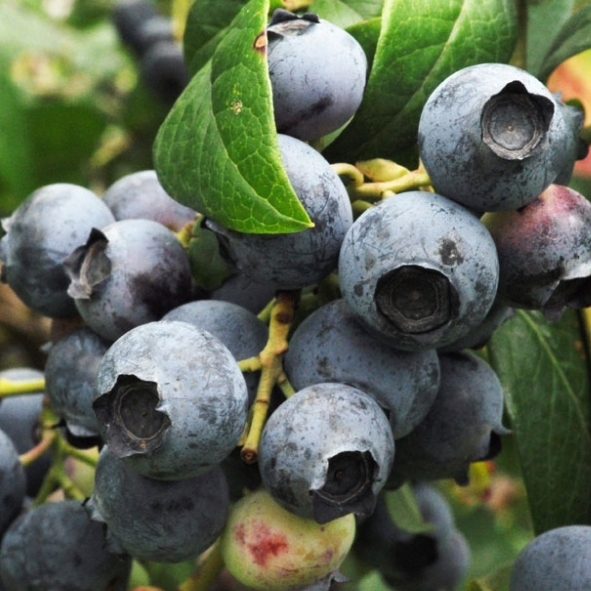
This blueberry variety has one of the largest bushes in the entire family, which grows up to 2 or sometimes more meters.The shrub has strong and resilient branches that can easily withstand strong gusts of wind, reliably holding the crop.
Separately, it is worth mentioning the high resistance of the shrub to cold weather, because it calmly withstands winters with temperatures up to -25 degrees, without the need for shelter. The shrub is able to withstand colder winters, but in this case it is recommended to cover it with a flooring (fortunately, the branches are elastic and easily bend to the ground without deforming).
As for the fruits themselves, they begin to ripen at the end of July, and reach condition by mid-August. The size of ripe berries is medium, and reaches a diameter of 1.7 cm, while the yield from one bush reaches 7, and sometimes even more, a kilogram, and this is a very impressive result.
The berry itself is colored dark blue and covered with a light waxy bloom. The berry has a mild aroma, but at the same time it has a taste combination, somewhat unusual for blueberries, of a sweet and subtle sourish hue, which makes it an excellent option for making jam, jam, and various kinds of cocktails.
The crown of the bush is not too lush, and given the large size of the plant, it looks rather rare. The leaves have a typical shape for most blueberry varieties;
Elizabeth
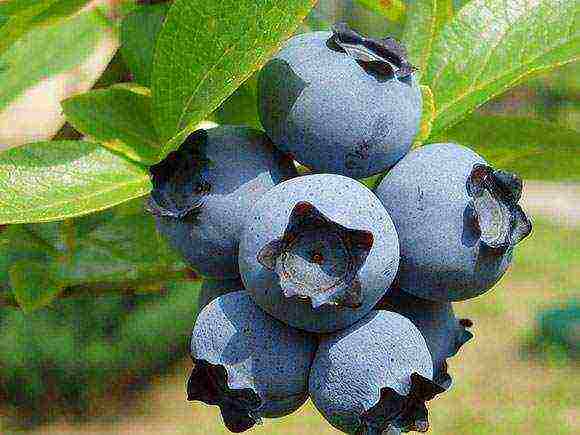
This variety is more modest in size, growing to a height of about 1.8 meters, but compensates for this with its more spreading crown, as well as high growth rates.
Moreover, this bush has red shoots, which, due to their structure, allow the bush to easily endure cold winters, up to -35 degrees, without requiring shelter (if possible, shelter will not damage).
The berries of the bush are large, and reach a diameter of 22 mm, while they have a dense structure that allows them to be transported over long distances without fear of losing their presentation. The berries are light blue, sometimes with shades of blue.
It is due to its large size and light color that this berry is depicted in most types of advertising related to products with added blueberries. The fruit also has an excellent and pronounced sweet taste, but not sugary, the fruit contains a large amount of sugar.
The crop begins to ripen in early August, but it does not ripen evenly, but at intervals of a couple of weeks. Up to 6 kg of berries can be harvested from one bush, which, given their size, is a very impressive result.
Elizabeth's blueberry is one of the most valuable berries in its family, and one of the most persistent. The crown, in comparison with most other blueberry bushes, boasts quite lush foliage. It is necessary to plant a bush in soil containing peat impurities. It is better not to plant the variety in sandy soils, so that it does not lag behind in growth;
Blues
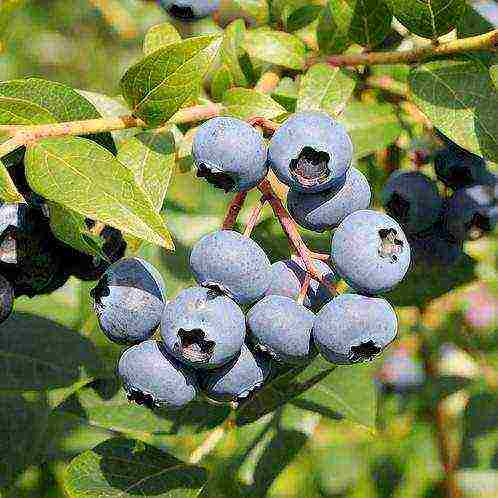
A very unusual and rare variety in the territory of the CIS countries, suitable for growing only in warm and temperate climates, with winters down to -25, or short-term frosts up to -35 degrees.
Despite this, if you managed to get hold of this variety and grow it successfully, you can be sure that you are lucky enough to have one of the most valuable blueberries on the planet. The fact is that the berry of this variety is large for blueberries, allowing it to reach a mass of 4 grams.
The bush begins to bear fruit in mid-July, and brings rather dense and crush-resistant berries, painted in a "deep" blue color, sometimes with shades of blue, and having an excellent sweet taste, according to the assurances of many gardeners, overshadowing all other varieties.
The productivity of the bush is also high, and almost always reaches 6 kg per bush. The variety belongs to tall shrubs, and its standard height reaches 1-8, less often 2 meters. The crown is lush, has leaves slightly larger than those of other blueberry varieties, with a slightly oblong shape;
Aino
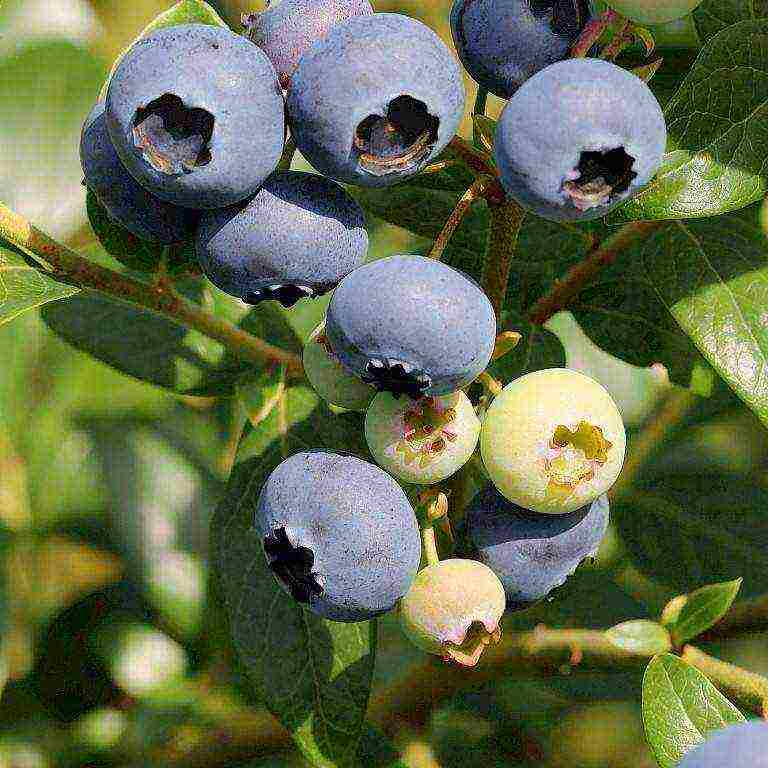
A shrub of modest size, the height of which rarely exceeds 90 cm, but this is compensated by the ability of the bush to grow in a horizontal direction, and has a high growth rate.
The variety perfectly tolerates severe winters, the temperature of which can reach -35 degrees. The bush blooms in May or June, and the harvest can be harvested in early August. The fruits are small in size, but at the same time they are distinguished by sweetness and a delicate, subtle aroma.
The color of the fruit is dark blue, most often without bloom, and in general, compared to other blueberry varieties, is less presentable. The crop matures gradually, over a period of 2 weeks. One bush can be harvested in the order of 7 kg.
The shrub has small leaves of a leathery structure, with a rounded shape, which shine in the sun;
Blue Swede
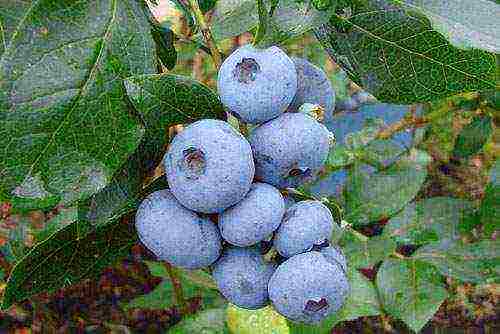
This blueberry variety was developed with a focus on widespread cultivation by both amateur gardeners and large companies on an industrial scale. The bush reaches a height of 90 to 150 cm, and has a width of about 100 cm.
The plant tolerates frosts down to -30 degrees. The variety begins to bear fruit quite early, and does this for a long time. So, the harvest begins from the end of June, and continues until July.
The fruit has a sweet taste, generally typical of blueberries. The color of the berries is light purple with a light matte finish. The berries are large in size, and can reach a weight of 3, sometimes 4 grams (not always and not all). The fruits are resistant to physical stress and can be transported without the risk of losing their aesthetic shape.
Berries are used most often for consumption raw, or for making jellies, jams and marmalade. From one bush during the fruiting season, you can collect up to 5-6 kg of fruit.
Fruiting rates can be higher with proper care and abundant feeding. The crown is notable for it, that in the fall its foliage acquires a red color, making the bush very aesthetic. The rest of the crown is unremarkable, and is standard for most blueberry varieties;
Bluecrop
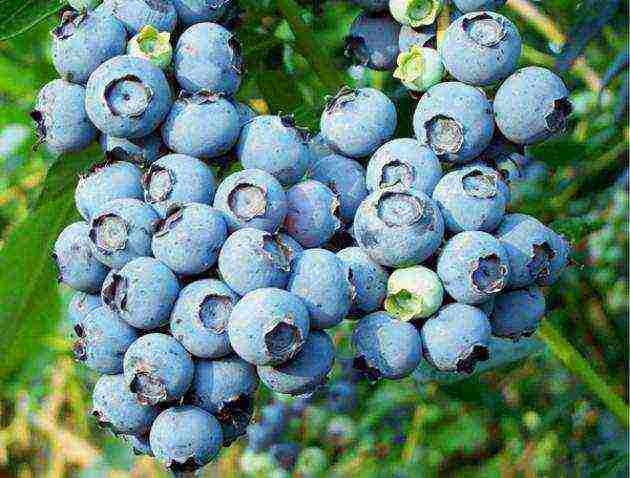
The bush of this variety reaches a height of 180 cm, and has an average growth rate, as well as a modest ability to grow in width. Despite this, this variety requires constant pruning and shaping, since if the bush grows, it will begin to bear small and soft fruits that will not have the proper gastronomic and aesthetic value.
With proper pruning, the fruits reach 20 mm in diameter, and a record 9 or even 10 kg of berries can be harvested from one bush. The fruits have a sweet taste with hints of powdered sugar, are light blue in color, and have a small scar. Fruits begin to ripen in mid to late July, ripening occurs almost simultaneously and evenly.
The crown of the bush has a lush structure, and in the fall, its leaves turn bright red, sometimes even pink and purple, which gives the impression of an unearthly origin of the bush. The frost resistance of the variety is also not satisfactory, and the plant is able to withstand winters down to -30 degrees, without preparation for winter;
Patriot
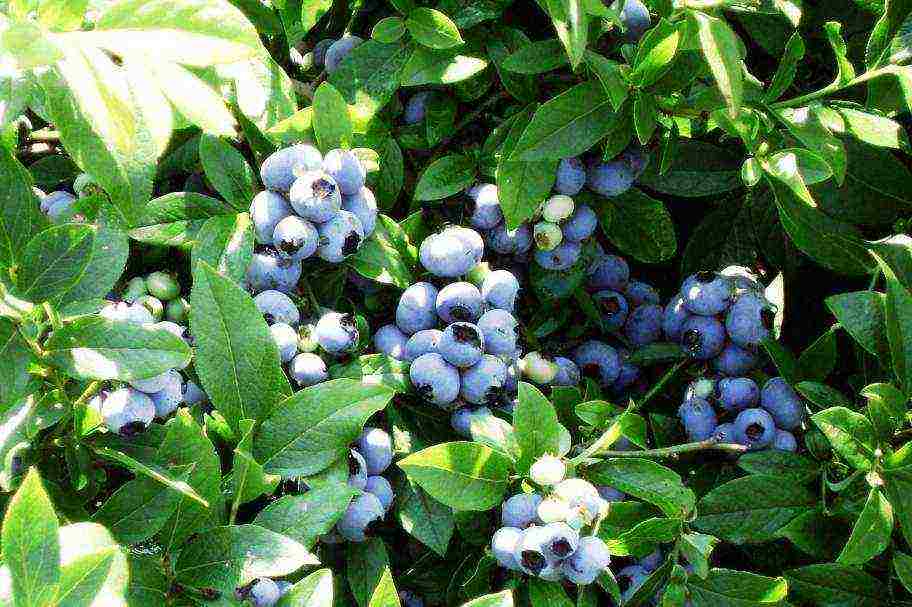
The bush reaches a height of up to 1.8 meters, and has a high growth rate, but at the same time a rather sparse crown. The bush does not tend to grow vertically, and grows straight up. This particular variety is one of the most resistant to diseases among other blueberry varieties.
So, the plant perfectly resists late blight, stem cancer, as well as godroniasis. The fruits begin to ripen around mid-July. The yield is consistently high, and always remains at a minimum at around 7 kg, and with good care it can reach up to 9 kg from one bush.
The fruits themselves are large in size, the diameter of which reaches 19 mm, while their shape is slightly flattened, and has a small and dry scar. The color of the fruit is light blue, the taste is sweet, but the structure of the pulp is somewhat dry, which is a kind of highlight, and only has a positive effect on the taste.
Berries grow in medium and large bunches. The crown is unremarkable and has a standard appearance for most blueberry varieties;
Bonus
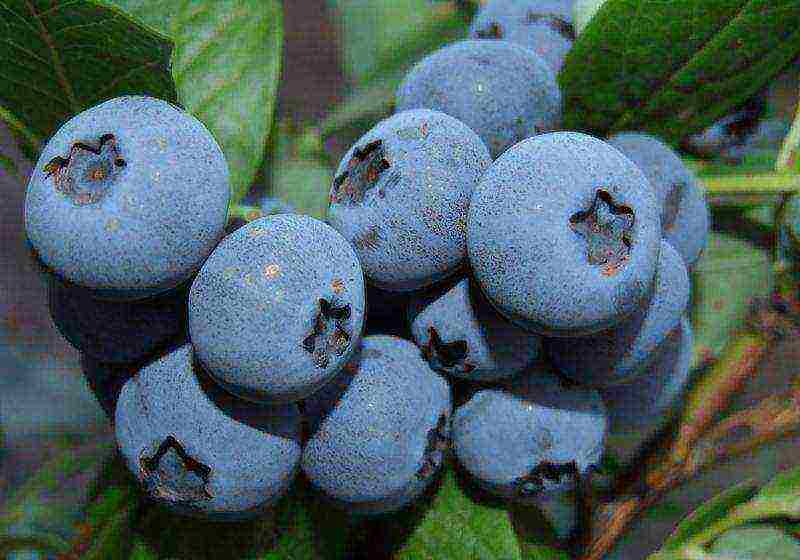
The bush grows up to 1.5 meters high and is not prone to overgrowth. The branches of the bush are vertical, growing upward, without bending to the ground. Under good conditions, the shrub can grow up to 2 meters, but this is usually an exception, not a fact.
The bush tolerates cold winters with temperatures down to -30 degrees, and when covered, it can withstand frosts down to -35 degrees or more, for a long time. The bush begins to bloom in the middle and even late spring, which is a great advantage, because this way the variety protects itself from the risk of frostbite on its buds during the early spring frosts.
Collecting the same fruits begins in July, and the fruits themselves, even after full ripening, do not fall off, and stay on the branches for about 10 more days. The berries are large in size, the diameter of which reaches 20-25 mm, and this is only an average indicator, there are also more.
The skin of the berry has a light blue color and elastic structure. The berry itself is resistant to damage and tolerates transportation well. The berry has a rather sweet taste, sometimes even slightly sugary, which is why it is best consumed raw or frozen.
Ripening occurs approximately simultaneously, and from one bush you can get about 5 kg of berries. The crown of this shrub has a decorative appearance, with large and rather lush leaves, as well as large clusters of large fruits. The foliage also turns red in the fall;
Jorma

This variety has bushes up to 1.2 meters high, and is prone to overgrowth, which means it must be cut and shaped every season. The growth rate of the bush is high, and besides the fact that it tends to grow horizontally, it grows well upward.
The frost resistance of this variety is beyond praise, since the plant tolerates frost at -35 degrees for a long time, and short-term frosts up to -39 degrees. The fruits are large in size, up to 18 mm in diameter, light blue, sometimes with shades of purple, as well as sweet-sour taste, and abundant anthocyanin content.
The fruits of this variety are suitable for making preserves, jams and berry fillings. Also, this variety has found its application in the creation of medicines and dietary supplements.
Harvesting begins in early August and lasts until the end. The variety is picky about the soil, and it is recommended to plant it in acidic soils in order to fully reveal its potential. The crown of the shrub is notable for its large leaves with a rich green color;
Northland
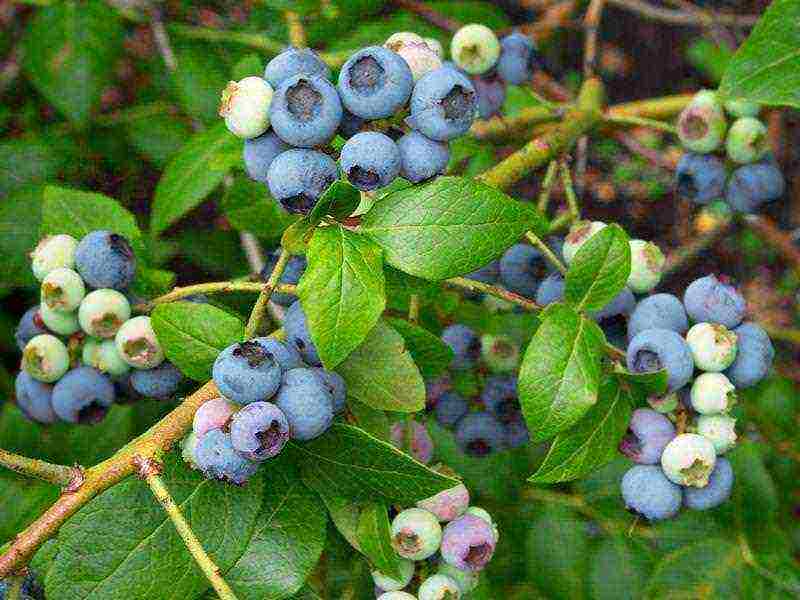
The variety has a rather low bush, the height of which rarely exceeds 1 meter, but this is compensated by the fact that the bush has a spreading shape, grows well, and does not require frequent shaping. Frost resistance is also high, withstands winters down to -30 degrees.
Separately, it is worth mentioning the yield, which can reach 8 kg from one bush, and this is a good indicator for a low-growing bush. The fruits are of medium size, and usually reach a weight of 1-1.5 grams, have a sweet taste, are light blue with a slight bluish bloom, have a dense structure, and are easy to transport.
Harvesting begins in mid-July. The crown is notable for its small leaves with a rich green color, as well as year-round green shoots. This means that although the variety can withstand frosts down to -30 degrees, if such are expected for more than a month, it will not damage the shelter of the bush before the onset of heat.
The most popular early varieties
If you are interested exclusively in early blueberry varieties that are suitable for growing in the middle climatic zone, and which will bear fruit from the second half of July, in addition to the samples presented above, pay attention to the following names:
- Rankocas;
- River;
- Sunrise;
- Puru;
- Duke;
- Erliblu.
Most popular late varieties
If you are looking for a late blueberry that starts bearing fruit in the second half of August, take a look at one of the following:
- Nelson;
- Spartan;
- Darrow;
- Toro;
- Jersey;
- Rubel;
- Covill;
- Berkeley.
Conclusion
As can be seen from the description, the overwhelming number of blueberry varieties suitable for our conditions have similar characteristics, almost the same frost resistance, minor differences in the taste and visual qualities of both the crown and the berries themselves.
In more detail, the significant differences between varieties affect the following points:
- Growing soil.
- Reproduction methods.
- Pruning methods.
- Feeding and fertilization methods.
- Disease susceptibility.
For more information on such differences between varieties, expect in the following articles, since the topic is very extensive and has a large amount of information.
Based on today's text, we can conclude that the best blueberry varieties for the middle lane are tall varieties oriented towards growing in regions with harsh winters, which allows you to get rid of the need for regular pruning, the need to cover the plant in winter, and will help you get more large and plentiful harvest.
You can also expect a more detailed description of blueberry varieties in the following articles!
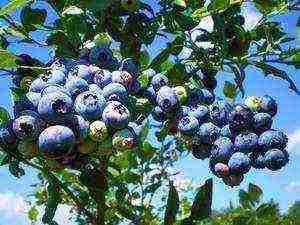 In the summer, each of us tries to replenish our body with vitamins, minerals and other useful substances for the whole year. The taste of summer is the taste of wild strawberry, strawberry, blueberry, blueberry, blackberry. The markets are overflowing with these berries and you can fully enjoy their unique taste and aroma.
In the summer, each of us tries to replenish our body with vitamins, minerals and other useful substances for the whole year. The taste of summer is the taste of wild strawberry, strawberry, blueberry, blueberry, blackberry. The markets are overflowing with these berries and you can fully enjoy their unique taste and aroma.
For blueberries and strawberries, you have to go to the forest. But blueberries, which are a close relative of blueberries and belong to the heather family, can be planted on your site and collected a good harvest throughout the summer.
Blueberries - tasty and healthy
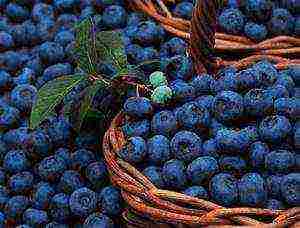 The main reasons why the berry is bred in summer cottages is its medicinal qualities. As for the taste, here it loses a little to blueberries, but the size of the fruits reminds more of a ripe cherry.
The main reasons why the berry is bred in summer cottages is its medicinal qualities. As for the taste, here it loses a little to blueberries, but the size of the fruits reminds more of a ripe cherry.
Useful properties of berries consist in hypoallergenic properties, the ability to strengthen the walls of blood vessels, normalize digestion, and have a positive effect on the state of the visual apparatus. Blueberries contain antioxidants and vitamins, as well as fiber that cleanses the intestines.
In appearance, the branchy bushes of the plant resemble blueberries. Usually their height does not exceed 50 cm, but there are varieties whose height can reach three meters. Blueberries are unpretentious, durable, resistant to diseases and pests. The yield of a crop depends on the variety. It can be improved by cross-pollination. From one bush harvested from 1.5 to 10 kg. The first fruits appear 3-4 years after planting.
Blueberry varieties
When characterizing a certain variety, attention is paid to the requirement for conditions, the size of the berries and the preferred yield. The best varieties include those that, under optimal climatic conditions, allow you to get the maximum amount of tasty and large berries.
The most popular blueberry varieties
When choosing a variety, you need to refer to indicators such as:
- expected harvest volume;
- the size and appearance of the berries;
- taste;
- frost resistance;
- requirement for climatic conditions;
- the life of the bushes;
- resistance to pests and diseases.
All blueberry varieties are divided into two main groups: undersized and tall. There are also northern, southern tall and medium-sized varieties, as well as varieties of the rabbit eye subgroup.
Stunted blueberries
The most popular varieties for cultivation in our regions are considered to be varieties of low-growing blueberries, which are distinguished by high frost resistance.
-
 Notreblue... The culture is a low-growing bush, the height of which does not exceed 0.9 meters. The harvest period begins in August.From one bush, you can collect from 1.2 to 2.5 kg of dense dark blue, large berries with a good taste, which are stored raw for a long time. Delicious and healthy fresh berries. Also, blueberries can be used for processing, making jams, jams, juices from them, or you can simply freeze them for the winter. The variety can withstand frosts up to 35 degrees. Bushes can additionally perform a decorative function on the site.
Notreblue... The culture is a low-growing bush, the height of which does not exceed 0.9 meters. The harvest period begins in August.From one bush, you can collect from 1.2 to 2.5 kg of dense dark blue, large berries with a good taste, which are stored raw for a long time. Delicious and healthy fresh berries. Also, blueberries can be used for processing, making jams, jams, juices from them, or you can simply freeze them for the winter. The variety can withstand frosts up to 35 degrees. Bushes can additionally perform a decorative function on the site. - Notrcantree... Powerful undersized bush with a short growing season. Berries begin to ripen in mid-July. Up to two kilograms of berries are harvested from one bush. The fruits are sweet, light blue in color, of medium size. The variety is not afraid of frost, therefore, it is suitable for growing in the northern zones. It is also appreciated for its decorative qualities.
- Chippewa... The height of the bushes varies on average from 80 to 100 cm. Light blue, large berries ripen early, have an excellent sweet taste, which allows them to be used for making pies, preserves, jams, jellies and other delicacies. Like the previous ones, this variety is frost-resistant, easily tolerates severe winters, withstanding frosts up to 30 degrees with a minus sign.
- Notland... A low-growing, powerful and spreading bush, the average height of which is about one meter. The variety is early, the fruits begin to ripen in mid-July. Regular good harvest - up to 8 kg per bush. Dense, blue, medium-sized berries have a pleasant sweet taste, are well stored and are excellent for making compotes, jams, preserves, jellies. This blueberry variety is quite frost-resistant, suitable for growing in the northern regions. A compact sprawling low bush will harmoniously decorate the landscape of the territory in which it grows.
- Bluegold... The variety was brought into mass production in 1988. The height of semi-spreading bushes does not exceed 120 cm. The fruits are sweet-sour, ripen quickly and quickly, after which they crumble. Mechanized harvesting is not recommended. Berries in the right conditions are stored for a long period. To prevent overloading of the branches, thinning and pruning are carried out. The blueberry variety is resistant to low temperatures, withstands up to 34 degrees with a minus sign.
Tall blueberry
Blueberry varieties of this group are not suitable for cultivation in cold and frosty winters, but they have a number of advantages. The yield can reach up to 10 kg per bush. Berries of tall varieties are larger and sweeter.
-
 Bluecrop... One of the best representatives of both his group and culture in general. Known since 1941. The height of an erect, vigorous bush ranges from 160 to 200 cm. 4–9 kg of berries are harvested from one bush. The plant withstands a lack of moisture, adapts to any soil. In areas with high humidity, it grows poorly, easily susceptible to shoot diseases. Light blue fruits are medium to large in size, slightly tart in taste.
Bluecrop... One of the best representatives of both his group and culture in general. Known since 1941. The height of an erect, vigorous bush ranges from 160 to 200 cm. 4–9 kg of berries are harvested from one bush. The plant withstands a lack of moisture, adapts to any soil. In areas with high humidity, it grows poorly, easily susceptible to shoot diseases. Light blue fruits are medium to large in size, slightly tart in taste. - Berkeley... The height of a sprawling, vigorous bush can reach 2.1 meters. The variety can be identified by its large, light green leaves. Bushes reproduce easily, they are able to withstand frost. Harvesting begins in the second half of August. The fruits are rather large (up to 18 mm in diameter), light blue with a small scar. The berries are sweet, but difficult to store and transport. The plant tolerates temperature changes well, does not require special care, and is used as a hedge.
- Elliot... The bushes of the plant are erect, vigorous, their height reaches two meters. Fruits are light blue with a small perianth. The ripening period begins in mid-September and ends in October. Fresh medium-sized berries can be stored for up to 12 weeks. You can improve yields by pruning the bushes. The variety does not like cold, damp areas, it can withstand frosts.
- Spartan... The height of a vigorous upright bush is up to 2 meters. The variety has been known in production since 1977.The ripening period begins in the second half of July. From one bush, from 4.6 to 6 kg of large, dense berries of a light blue hue are harvested, which are well transported and amenable to long-term storage. The taste of the berries is sour, the aroma is delicate and pleasant. Fresh fruit is recommended. The variety is not afraid of such diseases as mummification of berries, dying off of branches.
- Brigitte Blue... The variety is late. The bush of the plant reaches a height of 2 meters. The first berries begin to ripen in mid-August. From one bush, they collect from 4 to 6 kilograms. The berries are strong enough, light blue in color, up to 15 mm in diameter, taste sweet and sour. The variety is characterized by uniform ripening of fruits that do not crumble, are well transported and stored.
Medium blueberry
The varieties of this group are also known as semi-tall. Plants are skillfully bred for cultivation in the northern regions, as some representatives are able to withstand temperatures up to 40 degrees below zero.
-
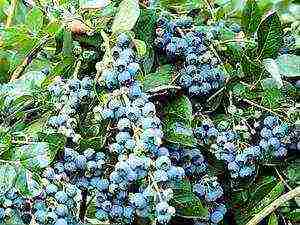 Patriot... It is one of the more popular blueberry varieties. The bushes grow quite quickly, their height does not exceed 1.5 meters. Their external difference is the sparse raised branches. The berries are very tasty and aromatic, with a dense skin, firm, flat, large, light blue. The ripening period lasts from July to August. This blueberry variety is recognized by many gardeners, due to its high yield, because up to 7 kg of berries are harvested from one bush. The plant is resistant to frost and common diseases.
Patriot... It is one of the more popular blueberry varieties. The bushes grow quite quickly, their height does not exceed 1.5 meters. Their external difference is the sparse raised branches. The berries are very tasty and aromatic, with a dense skin, firm, flat, large, light blue. The ripening period lasts from July to August. This blueberry variety is recognized by many gardeners, due to its high yield, because up to 7 kg of berries are harvested from one bush. The plant is resistant to frost and common diseases. - Duke... One of the best crop varieties. The height of an erect, vigorous bush ranges from 1.5 to 1.8 meters. Differs in a stable and high yield, ripens quickly and amicably, therefore, the collection, preferably manual, is carried out in 2-3 receptions. Light blue fruits are pleasant to the taste, sweetish-sour, sometimes slightly tart. The storage and transportability of the berries is relatively good. Early ripening is combined with late flowering to prevent damage to blueberries by spring frosts. The variety is frost-resistant, but grows very poorly in cold and damp areas.
- Chandler... The bushes reach a height of 1.5 meters, they are highly branched, fast-growing, erect. This blueberry variety is distinguished by large, blue, dense berries, the diameter of which reaches 20 mm, high and regular yield. The ripening period begins in August and lasts until mid-September.
Planting and leaving
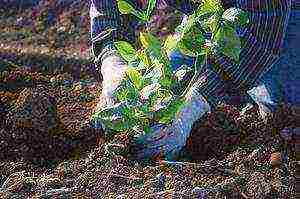 Blueberry yield depends on the growing conditions and care for it. The plant loves sunny places, sheltered from the wind, peaty, acidic soils. Blueberry roots go 30 cm deep. To provide the plant with the necessary substances, you can use soil from a pine forest with compost and deciduous humus.
Blueberry yield depends on the growing conditions and care for it. The plant loves sunny places, sheltered from the wind, peaty, acidic soils. Blueberry roots go 30 cm deep. To provide the plant with the necessary substances, you can use soil from a pine forest with compost and deciduous humus.
You can't feed the soil under blueberries with alkaline fertilizers (manure, humus, wood ash). Planting time is late autumn or early spring. The distance between the bushes depends on the type of blueberry. For undersized people it is 60 cm, for tall ones - 1–1.5 meters. After planting, it is recommended to mulch the land around the bushes with peat, sawdust or pine needles.
For propagation of blueberries, seeds, cuttings or cuttings are used. The last method is considered the most reliable. Lignified cuttings harvested in the fall are suitable here. When propagated by seeds, the first crop can be obtained in four years.
In order for blueberries to regularly produce generous crops, it is necessary to periodically feed the soil underneath. The plant does not need organic fertilizers, therefore, mainly mineral fertilizers are used - superphosphate, zinc, potassium, ammonium sulfate.
Blueberries need water regularlyespecially in hot weather. But, it is worth remembering that excess moisture can lead to a lack of air in the roots, as a result of which the plant will die. Low-growing varieties are watered only in dry, hot and not rainy summers.As a rule, they have enough natural moisture. Tall varieties are more in need of watering. To improve the condition of blueberries, the soil must be periodically loosened and mulched. In addition, the crop must be trimmed and cleaned, which is done in the fall after harvest or in the spring before the start of the growing season.
It is very important to choose the right blueberry variety, the choice of which depends on the local climate. So, in regions with cold, harsh winters, frost-resistant undersized or medium-sized varieties are planted. For regions with mild climates, any blueberry variety is suitable.
Blueberries in the garden are a very good solution. The culture is not picky and undemanding, it bears fruit well and can perform a decorative function. Blueberries are delicious, juicy and healthy. They contain a huge amount of vitamins and antioxidants, which have a positive effect on the health of the whole body. Blueberries are eaten raw and are recommended for people who suffer from vision problems. The fruits can be used to prepare preparations for the winter - preserves, jellies, jams, canning in their own juice. Blueberries keep well in the freezer and in cold winters will be a great find that will remind you of the taste of summer.
